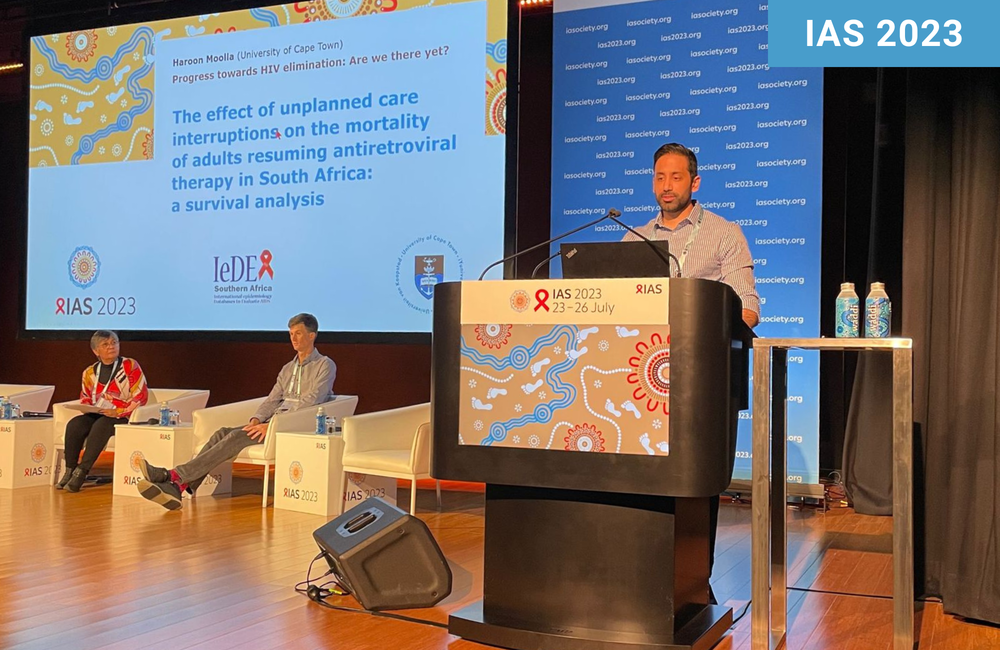
In an era when immediate treatment for all who are diagnosed with HIV is the norm, the focus of treatment studies is now turning to people who drop out of care, sometimes for long periods. In May, a study found there were more people with HIV in England who had dropped out of care than remained undiagnosed; soon afterwards a study from several African countries found evidence that up to half of all patients coming forward for treatment as new patients had in fact taken antiretroviral therapy (ART) before.
Now a study from South Africa has found that people who drop out of care for periods of more than six months but then later resume it are two to three times more likely to subsequently die, even though they restart ART: the health penalty of interrupting care persists.
Dr Haroon Moolla of the University of Cape Town told the 12th International AIDS Society Conference on HIV Science (IAS 2023) this week that the study collected data on people who interrupted therapy but then resumed it from several large patient cohorts in South Africa. It compared their subsequent mortality risk with people who had never interrupted care. Data collection started in 2004 and finished at the end of 2019.
This study did not look at all patients lost to follow up, or deaths in all patients lost to care – only at the death rate in those who restarted.
Care interruptions were defined as being a gap of more than 180 days (nearly six months) between last having access to ART and resuming care. Because most HIV prescriptions in South Africa are now for six months, a treatment interruption was defined as starting more than six months after their last clinic attendance. Subsequent interruptions, if they occurred, were amalgamated, as long as the person had restarted by the end of 2019. People who interrupted therapy were divided into two groups, those whose periods of missing care first started in their first six months after diagnosis and those who first dropped out of care later on.
A total of 63,421 adults with HIV were included in the cohort, contributing 188,358 person-years (so the average time spent in the cohort was three years).
The average age of participants was 33 and more than two-thirds (68%) were women. While only 10% started ART during the first four-year period of the study (2004-2007), getting on for half (44%) started it in the last four-year period of 2016-2019.
The majority of patients (64%) never interrupted their therapy. Of the 22,593 people who did, 39% started their first interruption within six months of presenting for care .
The average length of time out of care was 22.8 months, so nearly two years, with 25% resuming care within a year but another 25% stopping for more than three years.
There were a total of 3585 deaths among the 63,421 patients during the study period. People interrupting then resuming ART had increased mortality, compared to those without an interruption. The people whose first interruption occurred within six months of starting ART had 3.08 times the risk of death subsequently occurring during the study period, and those whose first interruption occurred after six months had 2.47 times the risk of dying. The mortality rate was 0.78% in people who did not interrupt their care (one death in 128 people per year) but was 1.6% in people whose first interruption was more than six months after starting ART (one death in 62.6 people per year), and 1.9% (one in 52.6) in people who first dropped out within the first six months.
Men had nearly 50% more risk of dying than women (hazard ratio, 1.47) and not surprisingly people who started ART with CD4 counts below 200 had three times the risk of dying compared with those who started with CD4 counts over 500. Also perhaps not surprisingly, the longer the interruption, the greater the risk of death; people whose interruptions were longer than nine months had a nearly 50% greater mortality risk.
There are limitations to this study that might vary the findings. Interruption in care does not necessarily mean interruption in ART in people who might have moved clinics in the interim or obtained it from other sources. A number of participants were excluded because of missing data, especially of their baseline CD4 counts. More importantly, a large-scale study like this that only collects basic data cannot collect more detailed socioeconomic data such as income, housing and domestic situations that might influence care persistence.
Dr Moolla commented, “The substantially increased mortality of those resuming ART after an interruption highlights the need to prioritise and support retention in care, particularly during the first six months of ART.”
Moolla H et al. The effect of unplanned care interruptions on the mortality of adults resuming antiretroviral therapy in South Africa: a survival analysis. 12th International AIDS Society Conference on HIV Science, Brisbane, abstract OAC0104, 2023.
